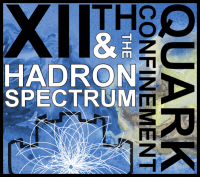Speaker
Description
Beyond perturbation theory gauge-fixing becomes more involved due to the Gribov-Singer ambiguity: The appearance of additional gauge copies requires to define a procedure how to handle them. For the case of Landau gauge the structure and properties of these additional gauge copies will be investigated. Based on these properties new gauge conditions are constructed to account for these gauge copies.
The dependence of the propagators on the choice of these complete gauge-fixings will then be investigated using lattice gauge theory for Yang-Mills theory. It is found that the implications for the infrared, and to some extent mid-momentum behavior, can be substantial. In going beyond the Yang-Mills case it turns out that the influence of matter can generally not be neglected. This will be briefly discussed for various types of matter.
Summary
Beyond perturbation theory gauge-fixing becomes more involved due to the Gribov-Singer ambiguity: The appearance of additional gauge copies requires to define a procedure how to handle them. For the case of Landau gauge the structure and properties of these additional gauge copies will be investigated. Based on these properties new gauge conditions are constructed to account for these gauge copies.
The dependence of the propagators on the choice of these complete gauge-fixings will then be investigated using lattice gauge theory for Yang-Mills theory. It is found that the implications for the infrared, and to some extent mid-momentum behavior, can be substantial. In going beyond the Yang-Mills case it turns out that the influence of matter can generally not be neglected. This will be briefly discussed for various types of matter.
